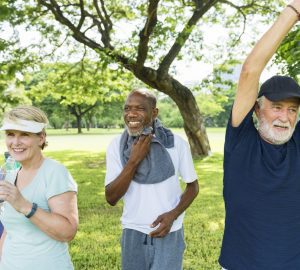The fitness industry, and sports in general, has always been very gendered and binary in its approach. A person is either categorized as male or female, and from there are assessed based on the physiological performances usually recorded for those two groups of people. While this approach is relatively accurate for the general population, it is very distressing and alienating for the percentage of the population that identifies outside of these two genders. We have the chance to live during a time where fitness training for transgender and non-binary identities are being talked about more openly and respectfully, and are finally being taken into consideration by our society. From bathrooms to change rooms, and the very language we use, we have started challenging the way we view gender, and how it is applied within our society. Therefore, the natural progression of this discourse is to challenge the gender dichotomy of fitness, and to look at ways to approach it in a more inclusive way.
To start out, it is important to make a distinction between sex and gender, and how it affects fitness. Sex is the biological makeup of a person, and can be determined by chromosomes (XX, XY, XXY, etc), reproductive organs, and secondary sex characteristics. There are three sexes; man, woman, and intersex. Gender, on the other hand, is the social and cultural representation of sex, and can vary from culture to culture. Gender is a spectrum, with male on one end and female on the other, and different degrees between. This is an important distinction to make because sex and gender are often confused with one another, and the roles imposed on each gender directly influences our perception of sex itself, and therefore physical performance. Transgender people usually feel like they were born in the body of the wrong sex, and gender-non-conforming people (or gender-queer, gender-neutral, etc) may feel like both male and female, neither, or anything in between. This challenges the very foundation of fitness and fitness training because it brings into question some of our pre-existing biases about the sexes and performance.
Sex-based segregation is not new to sports and fitness. It has been a long-time feature in organized sports. Historically, when women were allowed to participate, rules were put in place in order to keep the sexes segregated, which reinforced a flawed binary based on generalities rather than on individual skills and strengths. Fitness has been based on a concept of ‘male athletic superiority,’ and this sustains a hierarchy that privileges boys and men by categorizing their performance as superior. It has been argued, therefore, that segregation is required to ensure women have a ‘fair’ playing field. This hierarchichal view may lead to less opportunities and desire to participate due to women’s performance being undervalued. If girls are brought up thinking they are weaker and less athletic than their male counterparts, they may not put effort into fitness, nor want to participate in sports. If they do participate, they might not be treated as equals by the boys, which will impact performance due to lack of practice. Add the socialization of boys to think that losing to a girl in an athletic context is shamefull because of girls’ perceived athletic inferiority, and you have a self-fulfilling prophecy. These considerations are important to understand because sex-based segregation makes it difficult for transgender and gender non-conforming people to feel accepted and validated in fitness and sports, because they don’t fall into the category of ‘male’ or ‘female’.
This brings us to trans and gender non-conforming specific training, which is an under-researched and little recognized area of fitness. Amongst the various determinants of physical performance, testosterone is one of the most important when it comes to physiology. Therefore, we can apply this knowledge when we train people without making it about sex. We can apply this knowledge to categorize two different groups of trans and gender non-conforming people for fitness training purposes:
- Those with a natural hormonal balance; and,
- Those with hormone treatment or that have fully transitioned.
This creates the potential of using fitness as a way to strengthen the identity and the confidence of the client, while also creating an inclusive and individual-based method of viewing fitness and performance for everyone.
1) Trans and gender non-conforming people with a natural hormonal balance
Since the hormonal balance in this group of people most likely will be different than the hormonal balance in their desired sex, it is important to take extra consideration when training them. Testosterone will produce faster and more efficient muscle growth, and this might not match the goal of the client despite having a physiological predisposition for it, or vice-versa. For example, I have heard from certain male-to-female transgender people that they disliked pectoral exercises as it made the chest look too masculine. On the opposite end of the spectrum, female-to-male transgender people might want to focus on the pectorals in order to build muscle mass and reduce the size of the breasts, therefore achieving a more masculine look. It is important to work on a individual level to define what their definition of feminity and masculinity is.
2) Trans and gender non-conforming people with hormone treatment or that have fully transitioned
For this group of people, the focus should be on making sure that the client gets used to training with their new hormonal balance. This might seem strange, but there’s a learning curve when the body’s physiology has changed, especially when a client’s goal is fitness related. An example of this would be a male-to-female transgender person having a higher chance of knee/ankle injury stemming from loss of muscle mass in those areas, in addtion to the fact that they might not be aware that they have to strengthen that area because they never had to with their previous physiology.
Through all of this, I think it’s important to remember exactly what transgender and gender non-binary identities challenge: that sex is not everything physiologically and gender-wise. One transgender woman named Janae Kroczaleski was a world champion powerlifter before her transition to a woman from a man. Many would assume that to become a world class powerlifter, you would probably need a higher level of testosterone than average. For Janae, this was not the case at all. In fact, her level of testosterone was considered ‘low’ by male standards, and her estrogen level was high. She is one of the many examples we have that can change our view of sex, gender, and performance, from one that generalizes based on sex to one that focuses on the individual. This would not only benefit transgender and gender non-conforming people, but also the general population by deconstructing sex-based generalizations that male performance and athletic capabilities are superior. We know better than that now.
To read more about Janae’s story, visit www.muscleandfitness.com, the article name is ‘Transgender Powerlifter Janae Marie Kroc Shares Unbelievable Story’. For more information on transgender fitness, visit www.trans-health.com/fitness. There is also a yearly trans fitness convention, for more information, visit www.transfitcon.com
Author Bio:
Émilie/Emmett Lamache is a NAIT Personal Fitness Trainer student who identifies as gender-queer. She wants to focus on training the LGBTQA+ community upon graduation, with a specific focus on transgender and gender non-conforming people. The goal is to create an inclusive environment for everyone regardless of sex, gender, or sexual orientation, while providing the best holistic fitness services based on individual needs.








